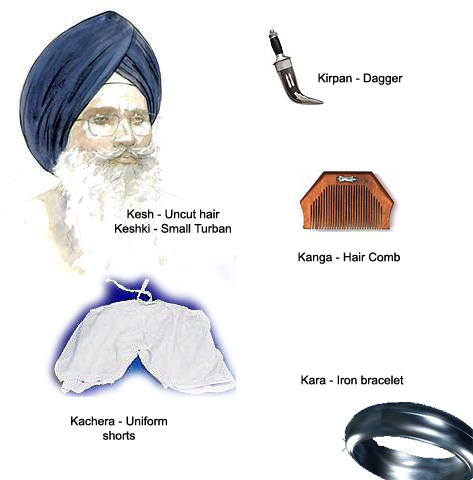Sikhism - Philosophy
5 K's
The 5Ks or kakkars or kakke are the five articles of faith worn by all baptised Sikhs. Many non-baptised Sikhs also begin on the path of Sikhi by wearing some or all of these Sikh symbols. The baptised Sikhs both male and female are required to wear a uniform to unify and bind them to their commitment to the true, universal, social and temporal principles defined and amplified by the ten Sikh Gurus and laid down in Sri Guru Granth Sahib. This commitment was publicly announced, made prominent and confirmed by Guru Gobind Singh in 1699 at the Vaisakhi gathering for all to witness.

- Kesh: (uncut hair) A Sikh is to maintain and adorn this natural God-given gift. To work with nature and not against it. The Kesh was covered with a turban, Keski or Chunni to keep it clean and manageable.
- Kanga (wooden comb) for the maintenance and ongoing upkeep of Kesh. A reminder to regularly maintain the body and mind in a clean and healthy state.
- Kara (steel bracelet or slave bangle): Symbolises an unbreakable bond with God. It is a constant reminder that the Sikh is a slave of the Lord. He or she must only do His work in accordance with the Holy Scripture; to abstain for wrong-doing at all times.
- Kachhera (cotton underwear) Standard, Naturally Comfortable, dignified attire reflective of modesty and control. A sign of a soldier; ever ready; dignified and highly mobile.
- Kirpan (a small sword) A sign that a Sikh is a soldier in "Akal Purakh's (God's) Army" (Akal Purakh de fauj); to maintain and protect the weak and needy and for self defence. Never to be used in anger.
Sikhism stands out as a unique and probably the only faith in the world where in there is no place what so ever for clergy or priestly class. It is self made, self contained, self regulating and dedicated to nothing but flawlessness in all aspects of human living. Flawlessness (or righteousness) is the very aim of human life. Numeral '1', is the first character that appears in the Sikh's holy script, the Guru Granth Sahib and is a textual icon for GOD and hence is the only holy number which a true Sikh believes in.
Unlike most other faiths where only the clergy are in uniform, all Sikhs are enjoined to always wear their uniform of faith at all times and to adhere to the ideals of the "Sant-Sapai" Saint-Soldier; to practise their belief always (rather than on just a particular day or time ie: just Sunday or Friday); to maintain and protect the cosmic balance in the world; to guard against tyranny, discrimination, evil and injustice. These five articles of faith distinguish a Sikh and are essential for preserving the life of the community founded on nothing but truthful living.
The Five Ks, or panj kakaar/kakke, are five items of faith which display and show the wearer's conviction to the Master and are a constant reminder of the adorner's love for the high principles set by their Leader and Commander-in-Chief; faith in the Khalsa; deep conviction to Satguru – the "timeless true Guru"; putting the values of the Khalsa above one's personal and materialist needs; the willingness to sacrifice one's life for the value set by the Sikh Gurus.
Sikhs remain spiritually and socially committed to 'the absolute TRUTH' and to wear these 5 Ks at all times in humble obedience of the Sprituo-Temproral command of the tenth Nanak, Guru Gobind Singh, who in 1699 during Amrit Sanchar at Baisakhi so ordained and commanded that all Sikhs uphold righteousness and stand by nothing but 'TRUTH'; to be born again as a new and better person; live a life of a saint-soldier; to turn a new leaf and lead a changed and renewed existence – somewhat detached and elevated from the previous "lesser" past life; and finally to call on and contemplate on the god of TRUTH ,Satguru and to totally merge in with this divine spirit.
Following pages regarding the 5 K's, including the content above is from: http://www.sikhiwiki.org/index.php/Main_Page




